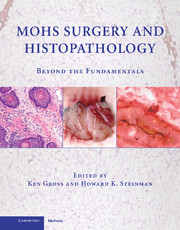Book contents
- Frontmatter
- Contents
- CONTRIBUTORS
- MOHS SURGERY AND HISTOPATHOLOGY
- PART I MICROSCOPY AND TISSUE PREPARATION
- Chap. 1 INTRODUCTION
- Chap. 2 HOW TO EXCISE TISSUE FOR OPTIMAL SECTIONING
- Chap. 3 OPTIMIZING THE MOHS MICROSCOPE
- Chap. 4 TISSUE PREPARATION AND CHROMACODING
- Chap. 5 EMBEDDING TECHNIQUES
- PART II INTRODUCTION TO LABORATORY TECHNIQUES
- PART III MICROANATOMY AND NEOPLASTIC DISEASE
- PART IV SPECIAL TECHNIQUES AND STAINS
- INDEX
Chap. 2 - HOW TO EXCISE TISSUE FOR OPTIMAL SECTIONING
from PART I - MICROSCOPY AND TISSUE PREPARATION
Published online by Cambridge University Press: 03 March 2010
- Frontmatter
- Contents
- CONTRIBUTORS
- MOHS SURGERY AND HISTOPATHOLOGY
- PART I MICROSCOPY AND TISSUE PREPARATION
- Chap. 1 INTRODUCTION
- Chap. 2 HOW TO EXCISE TISSUE FOR OPTIMAL SECTIONING
- Chap. 3 OPTIMIZING THE MOHS MICROSCOPE
- Chap. 4 TISSUE PREPARATION AND CHROMACODING
- Chap. 5 EMBEDDING TECHNIQUES
- PART II INTRODUCTION TO LABORATORY TECHNIQUES
- PART III MICROANATOMY AND NEOPLASTIC DISEASE
- PART IV SPECIAL TECHNIQUES AND STAINS
- INDEX
Summary
THE GOAL OF MOHS surgery is to cure skin cancer. Optimization of Mohs surgery ensures that the high cure rates available with this technique are achieved in practice. Production of the highest-quality Mohs slides makes possible the most accurate interpretation of the surgical margins represented on those slides. The Mohs surgeon, by optimizing tissue excision at the operative table, allows the Mohs technician to produce high-quality slides that present complete surgical margins of all excised tissue.
A masterful Mohs technician may be able to salvage tissue excised with poor surgical technique, and a poor technician can make garbage from an exquisite surgical specimen. In this chapter we focus on issues of surgical technique that will help the competent Mohs technician prepare better slides and allow faster and more cost-effective Mohs surgery. Optimizing surgical technique allows for the most favorable slide preparation. The Mohs surgeon, when switching hats and becoming the Mohs pathologist, will then have the best chance of making accurate surgical margin assessments.
HOW TO EXCISE TISSUE FOR OPTIMAL SECTIONING
Even before making the first incision, the Mohs surgeon can increase the chance for complete cancer removal in as few stages as possible. The clinical margins of the tumor should be assessed with bright light and magnification. Use of an episcope and Wood's light may help define the margins of some cancers, especially pigmented lesions. Re-assess the clinical margins after injection of anesthesia, as tumor margins may become more distinct after injection.
- Type
- Chapter
- Information
- Mohs Surgery and HistopathologyBeyond the Fundamentals, pp. 5 - 14Publisher: Cambridge University PressPrint publication year: 2009



